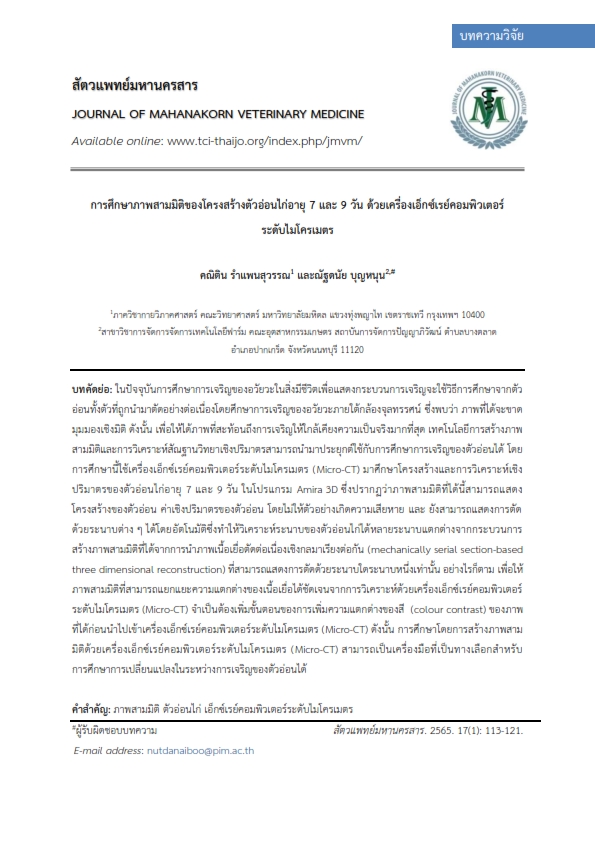The Study of Three-dimensional Image of the Structure in 7 and 9 Days Old Chick Embryos from Micro-computed Tomography (Micro-CT)
Main Article Content
Abstract
Currently, the study of organ development in organisms uses both serial sections and whole-mount under microscope examination. Despite the fact that these developmental processes are well defined, the dimension often overlooked in order to obtain the most precise images. Thus, 3D reconstruction and morphometry are applied for illustrating of the embryonic development. In this study, the micro-computed tomography (micro-CT) was applied and analyzed morphometrically and volumetrically in Amira 3D software. The 3D model from the reconstruction showed the structure of the embryo as well as the volume of chick embryos without causing any damage to the samples. It was also possible to automatically display sectioning in different planes, allowing for the analysis of multiple planes of chick embryos, as compared to mechanically serial section-based three dimensional reconstruction, which was only capable of displaying sectioning in particular plane. However, in order to generate a three-dimensional image that clearly distinguishes tissue from micro-computed tomography (micro-CT) analysis, it is necessary to add a step of enhancing the color contrast of the image before it is placed into the micro-computed tomography (micro-CT). Thus, this study of 3D image of the structure of chick embryos from Micro-computed tomography (micro-CT) can be used to demonstrate morphological changes in embryonic development.
Article Details

This work is licensed under a Creative Commons Attribution-NonCommercial-NoDerivatives 4.0 International License.
References
Arey, L.B. 1974. Developmental anatomy: A textbook and laboratory manual of embryology. 7th ed. Saunders, Inc. Philadelphia. 695 p.
Bellairs, R. and Osmond, M. 2014. The atlas of chick development. 3rd ed. Academic Press. Oxford. 692 p.
Boonnoon, N., Chotyakul, N., and Kruepunga, N. 2016. Effects of soybean phytoestrogens on the development of avian reproductive system. Panyapiwat J. 8: 272-283.
Boonnoon, N., Chandee, N., and Kruepunga, N. 2019. Three-dimensional Image Reconstruction of the Developing Pelvic Region in 9-day-old Chick Embryos. TJST. 28(6): 1087-1097. (in Thai)
de Bakker, B.S., de Jong, K.H., Hagoort, J., de Bree, K., Besselink, C.T., de Kanter, F.E.C., Veldhuis, T., Bais, B., Schildmeijer, R., Ruijter, J.M., Oostra, R. J., Christoffels, V.M. and Moorman, A.F. 2016. An interactive three-dimensional digital atlas and quantitative database of human development. Science. 354. doi: 10.1126/science.aag0053.
Hikspoors, J.P., Soffers, J.M., Mekonen, H.K., Cornillie, P., Köhler, S.E. and Lamer, W.H. 2015. Development of the human infrahepatic inferior caval and azygos venous systems. J. Anat. 226: 113-25.
Kruepunga, N., Hikspoors, J.P., Mekonen, H.K., Mommen, G.M., Meemon, K., Weerachatyanukul, W., Asuvapongpatana, S., Köhler SE. and Lamer, W.H. 2018. The development of the cloaca in the human embryo. J. Anat. 234: 724-739.
Kruepunga, N., Hikspoors, J. P. J. M., Hülsman, C. J. M., Mommen, G. M. C., Köhler, S. E., & Lamers, W. H. 2020a. Development of extrinsic innervation in the abdominal intestines of human embryos. J. Anat. 237(4): 655-671.
Kruepunga, N., Hikspoors, J. P. J. M., Hülsman, C. J. M., Mommen, G. M. C., Köhler, S. E., & Lamers, W. H. 2020b. Extrinsic innervation of the pelvic organs in the lesser pelvis of human embryos. J. Anat. 237(4): 672-688.
Mekonen, H.K., Hikspoors, J.P., Mommen, G., Kruepunga, N., Köhler, S.E. and Lamers, W.H. 2017. Closure of the vertebral canal in human embryos and fetuses. J. Anat. 231: 260–274.
Pentecost, J.O., Icardo, J. & Thornburg, K.L. 1999. 3D Computer modeling of human cardiogenesis. Computerized Medical Imaging and Graphics. 23: 45-49.
van den Berg, G. & Moorman, A.F. 2011. Development of the pulmonary vein and the systemic venous sinus: an interactive 3D overview. PLoS One.6: e22055.
Watterson, R.L. & Sweeney, R.M. 1973. Laboratory studies of chick, pig and frog embryos. Burgess Pub. Co. Minneapolis. 206 p.


